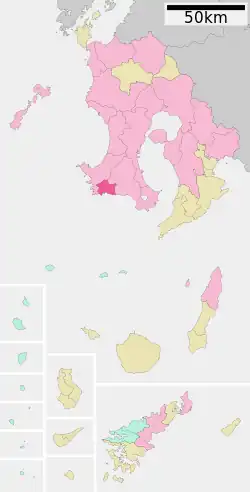Makurazaki, Kagoshima
Makurazaki (枕崎市, Makurazaki-shi) is a city located in Kagoshima Prefecture, Japan. The city was founded on September 1, 1949.
Makurazaki
枕崎市 | |
|---|---|
 View of Makurazaki | |
 Flag  Chapter | |
Location of Makurazaki in Kagoshima Prefecture | |
 | |
 Makurazaki Location in Japan | |
| Coordinates: 31°16′22″N 130°17′49″E | |
| Country | Japan |
| Region | Kyushu |
| Prefecture | Kagoshima Prefecture |
| Government | |
| • Mayor | Yoshiaki Setoguchi |
| Area | |
| • Total | 74.88 km2 (28.91 sq mi) |
| Population (April 1, 2017) | |
| • Total | 21,960 |
| • Density | 290/km2 (760/sq mi) |
| Time zone | UTC+09:00 (JST) |
| City hall address | 27, Chiyodachō, Makurazaki-shi, Kagoshima-ken 898-8501 |
| Climate | Cfa |
| Website | www |
| Symbols | |
| Flower | Chrysanthemum |
| Tree | Camellia |
As of April 2017, the city has an estimated population of 21,960 and a population density of 290 persons per km².[1] The total area is 74.88 km².
It is famous for its katsuobushi processing plants, which produce the chief flavoring ingredient—dried fish flakes—found in Japanese miso soup. About 70 small family businesses year-round boil, cut, dry and smoke the pungent fish, often sending a unique odor of steam, smoke and fish scent across the downtown area and out to sea.
Makurazaki is the site of the terminus of the southernmost JR train line in Japan, the Ibusuki Makurazaki Line. The Japanese know the town as the Typhoon Ginza (after Ginza in Tokyo). Each summer many cyclones strike the main islands first in the area of Makurazaki.
Geography
Climate
Makurazaki has a humid subtropical climate (Köppen climate classification Cfa) with hot summers and mild winters. Precipitation is high throughout the year, and is especially high from May to July. The highest record temperature was 36.9 °C (98.4 °F) on August 18, 2020 while the lowest recorded temperature was −4.4 °C (24.1 °F) on February 19, 1977.[2]
| Climate data for Makurazaki (1991−2020 normals, extremes 1923−present) | |||||||||||||
|---|---|---|---|---|---|---|---|---|---|---|---|---|---|
| Month | Jan | Feb | Mar | Apr | May | Jun | Jul | Aug | Sep | Oct | Nov | Dec | Year |
| Record high °C (°F) | 22.8 (73.0) |
22.8 (73.0) |
24.5 (76.1) |
28.4 (83.1) |
30.2 (86.4) |
32.6 (90.7) |
35.3 (95.5) |
36.9 (98.4) |
34.8 (94.6) |
32.7 (90.9) |
27.5 (81.5) |
24.3 (75.7) |
36.9 (98.4) |
| Average high °C (°F) | 12.9 (55.2) |
14.0 (57.2) |
16.8 (62.2) |
20.6 (69.1) |
24.1 (75.4) |
26.4 (79.5) |
30.2 (86.4) |
31.4 (88.5) |
29.2 (84.6) |
25.2 (77.4) |
20.3 (68.5) |
15.2 (59.4) |
22.2 (72.0) |
| Daily mean °C (°F) | 8.9 (48.0) |
9.9 (49.8) |
12.6 (54.7) |
16.5 (61.7) |
20.1 (68.2) |
23.2 (73.8) |
27.0 (80.6) |
27.8 (82.0) |
25.3 (77.5) |
20.8 (69.4) |
15.8 (60.4) |
10.9 (51.6) |
18.2 (64.8) |
| Average low °C (°F) | 5.0 (41.0) |
5.6 (42.1) |
8.3 (46.9) |
12.2 (54.0) |
16.2 (61.2) |
20.4 (68.7) |
24.4 (75.9) |
24.8 (76.6) |
22.0 (71.6) |
16.8 (62.2) |
11.6 (52.9) |
6.8 (44.2) |
14.5 (58.1) |
| Record low °C (°F) | −3.3 (26.1) |
−4.4 (24.1) |
−1.7 (28.9) |
0.0 (32.0) |
5.0 (41.0) |
11.2 (52.2) |
16.6 (61.9) |
16.9 (62.4) |
10.7 (51.3) |
4.6 (40.3) |
−0.5 (31.1) |
−3.0 (26.6) |
−4.4 (24.1) |
| Average precipitation mm (inches) | 96.2 (3.79) |
114.3 (4.50) |
167.6 (6.60) |
188.3 (7.41) |
196.7 (7.74) |
512.9 (20.19) |
306.9 (12.08) |
181.0 (7.13) |
236.2 (9.30) |
94.8 (3.73) |
129.3 (5.09) |
111.6 (4.39) |
2,335.6 (91.95) |
| Average snowfall cm (inches) | 1 (0.4) |
trace | 0 (0) |
0 (0) |
0 (0) |
0 (0) |
0 (0) |
0 (0) |
0 (0) |
0 (0) |
0 (0) |
0 (0) |
1 (0.4) |
| Average precipitation days (≥ 1.0 mm) | 10.5 | 10.0 | 12.6 | 9.9 | 9.9 | 15.1 | 9.9 | 9.8 | 10.0 | 7.1 | 8.9 | 9.8 | 123.5 |
| Average snowy days (≥ 1 cm) | 0.3 | 0.2 | 0 | 0 | 0 | 0 | 0 | 0 | 0 | 0 | 0 | 0 | 0.5 |
| Average relative humidity (%) | 68 | 68 | 69 | 71 | 75 | 83 | 82 | 79 | 77 | 72 | 72 | 70 | 74 |
| Mean monthly sunshine hours | 109.9 | 121.3 | 153.2 | 173.2 | 176.9 | 109.5 | 203.0 | 222.8 | 186.7 | 181.8 | 149.3 | 125.6 | 1,913.1 |
| Source: Japan Meteorological Agency (records 1872–present)[2][3][4] | |||||||||||||
Demographics
Per Japanese census data, the population of Makurazaki in 2020 is 20,033 people.[5] Makurazaki has been conducting a census since 1920, and the city's population peaked in the 1950s at more than 35,000 people; the population has declined slowly since then. The population of Makurazaki in 2020 is only 70% of the 1955 census.
| Year | Pop. | ±% |
|---|---|---|
| 1920 | 23,577 | — |
| 1925 | 24,920 | +5.7% |
| 1930 | 27,239 | +9.3% |
| 1935 | 28,000 | +2.8% |
| 1940 | 29,057 | +3.8% |
| 1945 | 32,717 | +12.6% |
| 1950 | 34,480 | +5.4% |
| 1955 | 35,546 | +3.1% |
| 1960 | 33,511 | −5.7% |
| 1965 | 31,464 | −6.1% |
| 1970 | 30,084 | −4.4% |
| 1975 | 29,685 | −1.3% |
| 1980 | 30,060 | +1.3% |
| 1985 | 30,099 | +0.1% |
| 1990 | 28,794 | −4.3% |
| 1995 | 27,640 | −4.0% |
| 2000 | 26,317 | −4.8% |
| 2005 | 25,150 | −4.4% |
| 2010 | 23,645 | −6.0% |
| 2015 | 22,046 | −6.8% |
| 2020 | 20,033 | −9.1% |
| Makurazaki population statistics[5] | ||
References
- "Official website of Makurazaki City" (in Japanese). Japan: Makurazaki City. Retrieved 7 May 2017.
- 観測史上1~10位の値( 年間を通じての値) (in Japanese). Japan Meteorological Agency. Retrieved April 20, 2015.
- 気象庁 / 平年値(年・月ごとの値) (in Japanese). Japan Meteorological Agency. Retrieved April 20, 2015.
- 気象庁 / 平年値(年・月ごとの値) (in Japanese). Japan Meteorological Agency. Retrieved April 20, 2015.
- Makurazaki population statistics
External links
- Makurazaki City official website (in Japanese)
- Makurazaki Katsuobushi official website
 Geographic data related to Makurazaki, Kagoshima at OpenStreetMap
Geographic data related to Makurazaki, Kagoshima at OpenStreetMap